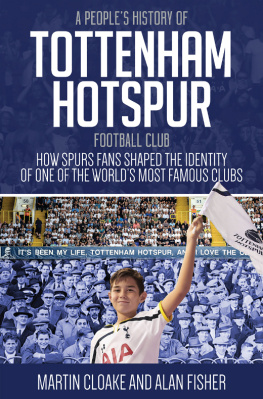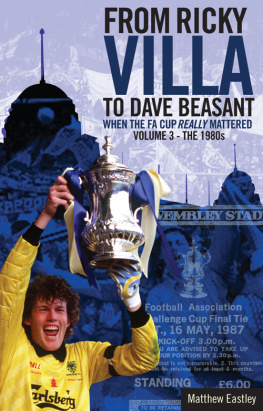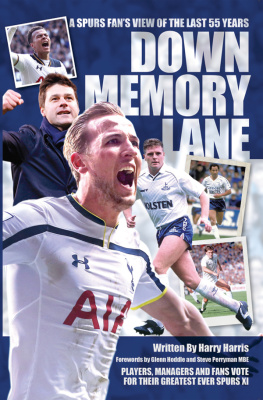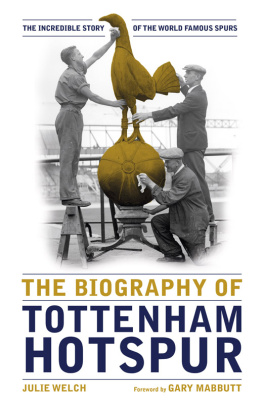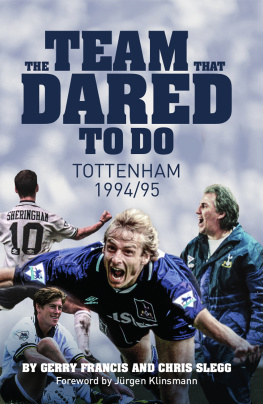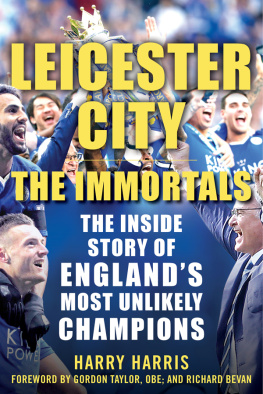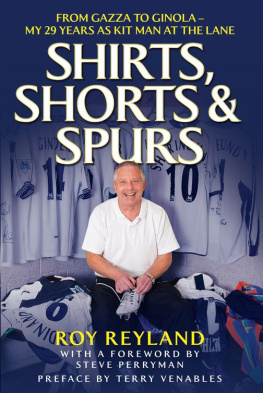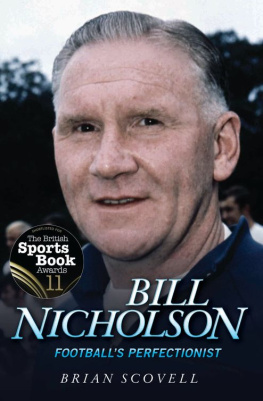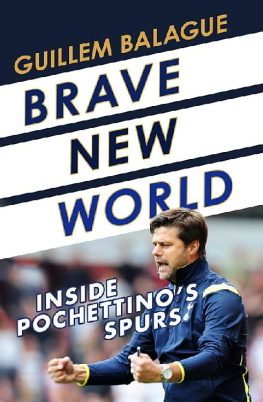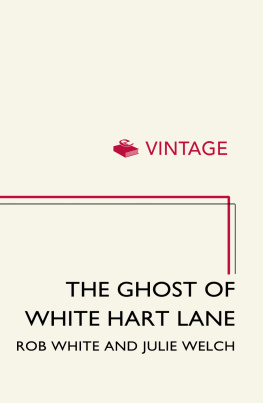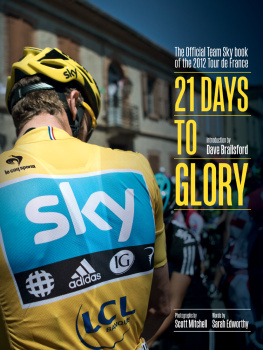THE BOYS FROM WHITE HART LANE
Martin Cloake & Adam Powley
In Memory of Tony Fuller
MARTIN
To Mum, who wondered if me going to see this team was a good idea, and to Cath, Daniel and Tom
ADAM
For all the family and for much-missed dad, who first took me to see the boys from White Hart Lane
This electronic edition Published by Vision Sports Publishing in 2011
Vision Sports Publishing Ltd
2 Coombe Gdns
London SW20 0QU
www.visionsp.co.uk
First published by Vision Sports Publishing in 2008
This paperback edition published by Vision Sports Publishing in 2011
Epub ISBN: 978-1907637-10-0
Book ISBN: 978-1907637-08-7
Text Martin Cloake & Adam Powley
All rights reserved. No part of this publication may be reproduced, stored in a retrieval system, or transmitted in any form or by any means, electronic, mechanical, photocopying, recording or otherwise, without the prior permission of the publishers.
This book is sold subject to the condition that it shall not, by way of trade or otherwise, be lent, re-sold, hired out or otherwise circulated without the publishers prior consent in any form of binding or cover other than that in which it is published and without a similar condition including this condition being imposed on the publisher.
Editor: Jim Drewett
Design: Doug Cheeseman
Copy editor: Ian Turner
Special thanks to Panini for kindly allowing us use of the fantastic football cards on the front cover.
www.paninigroup.com
A CIP catalogue record for this book is stored at the British Library
ACKNOWLEDGEMENTS
Producing this book has been an inspiring experience for us, not only because it gave us the chance to meet the players we watched as kids and get the inside story of the team we still think of as ours. Whats also been inspiring is the goodwill and enthusiasm weve encountered along the way.
First mention must go to Steve Perryman. Without him, this book would never have happened. He has spent long hours speaking to us about his experiences, contacting the players and vouching for our integrity as Spurs-supporting writers when we were pestering his old team-mates to give us an insight into the close-knit world of the dressing room. Along the way, Steve has provided many thoughtful suggestions and much background information. He is also one of the most genuinely friendly and straightforward people weve ever had the pleasure of working with as he would say, a proper fella.
Jim Drewett and Toby Trotman at Vision Sports Publishing also deserve a special mention. They have showed enormous faith in us and their understanding of and passion for sport has enabled us to produce something which, we hope, provides a portrait of the times in line with the vision they had when establishing VSP. Their support and style of work on editorial and marketing matters is much appreciated, as is their willingness to respond to our frequent and varied questions with good humour and honesty. We are pleased to count them as good friends as well as colleagues.
Many other people have played their part in helping produce this book. The knowledge and accessibility of Spurs historian Andy Porter and statistician and historian Bob Goodwin have been invaluable, and we thank them for providing definitive answers to our questions. Paul Allen at the Professional Footballers Association also put in some much-appreciated effort on our behalf, as did Pablo Ardiles.
Thanks to Doug Cheeseman for his creativity and expertise in designing a cover that really does convey the spirit of the times and to Clive Batty for bringing his keen eye to bear on what must have been painful reading for a true Blue!
Weve had many conversations with fellow Spurs fans, friends, and sports writers, all of whom have informed our approach to writing this book. For this, we would like to thank, in no particular order, Jim Duggan, Julie Welch, Bruce Lee, Bernie Kingsley, Steve Davies, Annelise Jespersen, Nick Auer, Julian Richards, Rick Mayston, Justyn Barnes, Phil and Ian Katz, Rabbi Crackers, Crocket, Pete Panayi and Andy Breckenbridge.
As always, our families have had to put up with us hiding away tapping at keyboards until late into the night, heading off at short notice to do interviews and spending vast amounts of time emailing and phoning each other to discuss the production of this book. Their support and understanding does not go unnoticed.
The last word of thanks must go to the players themselves, who gave up hours of their time to speak to us in depth about their experiences, and who in some cases welcomed us into their homes as well as their confidences. It was a pleasure to meet them, and to be reminded of what football and footballers used to be. Thank you to Ossie Ardiles, Ricky Villa, Tony Galvin, Graham Roberts, Paul Miller, Garry Brooke, Tony Parks, George Mazzon and Peter Shreeve the boys from White Hart Lane.
INTRODUCTION
There is a time in a football fans life when one team comes to symbolise all that is best about his or her club. For a large number of Tottenham supporters now comfortably settled into middle age, that side was the one managed to cup-winning glory by Keith Burkinshaw. It was this team that gave us our legends, won trophies with a generous dose of style and swagger and, perhaps, laid a few ghosts to rest.
Burkinshaws Spurs were appreciated by a wider audience too. While football fans, more than the fans of any other sport, tend to follow teams rather than the sport itself, a side occasionally comes along that commands respect or admiration across the partisan lines of the football tribes. Brian Cloughs Nottingham Forest were one such team, their rise from second tier also-rans to double European Champions in four consecutive seasons still fondly remembered because it kept alive the very essence of sport that everyone has a chance of winning.
Tottenham Hotspur commanded similar emotions between 1978 and 1987. The Guardians Patrick Barclay captured the mood, writing in 1982 when the team was riding high: If every team played like Spurs, footballs only problem would be in pacifying the herds of supporters unable to get into packed grounds. They bring beauty to the game, and people like that.
We all have our favourite recollections of that era. The games themselves naturally stand out: 1984s epic UEFA Cup final and the vocal support for Danny Thomas following his missed penalty that still brings a lump to the throat at the memory; the first half demolition of Feyenoord in the same campaign; the fans takeover of Highbury for the 1981 semi-final replay and the titanic, title-deciding clash with Everton in 1984/85. Even for those not present to witness Ricky Villas extraordinary FA Cup final goal in 1981, it became our JFK moment: we all remember where we were when it happened.
But its the personal memories, the individual rites-of-passage details, that really forge the link between fans and a team. The authors of this book are no exception.
Adam Powley remembers: Unable to get a ticket for the 1981 FA Cup final replay, I was forced to watch the match on TV in a schoolmates front room in Southgate, north London. We were wearing naff silky quartered caps that seemed quite snazzy at the time. Villas goal prompted bedlam. We danced out into the road, a gaggle of 14-year-olds unsure how to react to our hitherto underachieving team threatening to win something of significance. We could hear cheers ringing out around the whole area, before everyone hurriedly rushed back inside to sit through the longest, most painful 12 minutes, until the final whistle brought unconfined relief.


